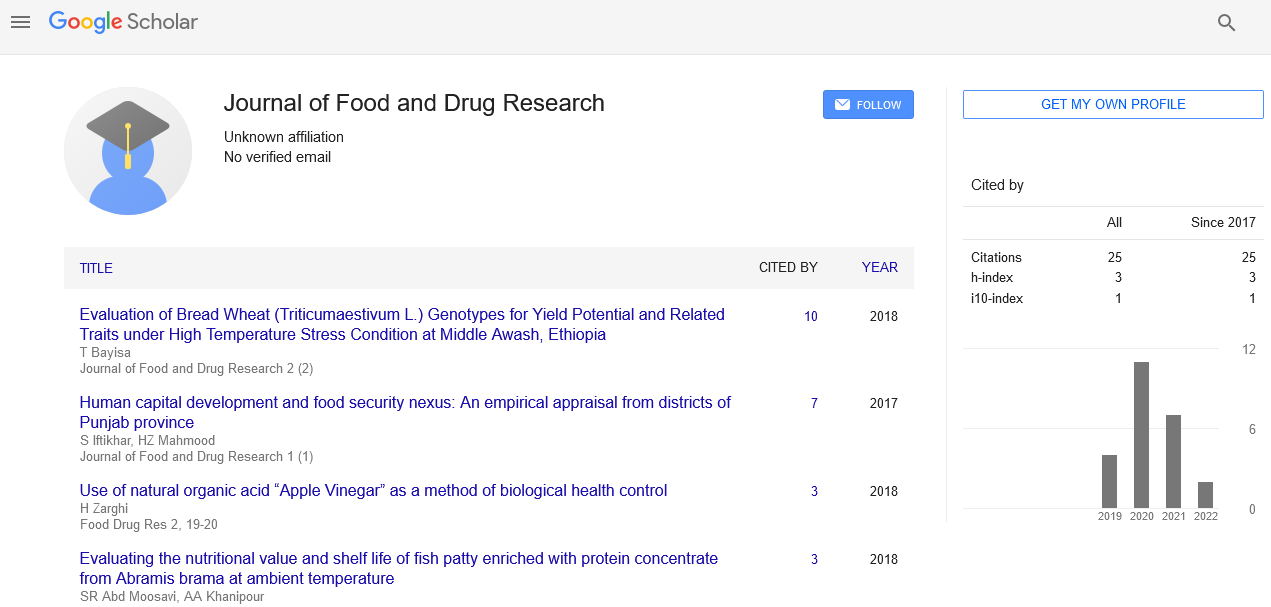Importance and current status of the gastrointestinal digestion effect on drugs and food
Received: 30-Nov-2017 Accepted Date: Dec 01, 2017; Published: 01-Dec-2017
Citation: Antonio J NF. Importance and current status of the gastrointestinal digestion effect on drugs and food. J Food Drug Res. 2017;1(1):18.
This open-access article is distributed under the terms of the Creative Commons Attribution Non-Commercial License (CC BY-NC) (http://creativecommons.org/licenses/by-nc/4.0/), which permits reuse, distribution and reproduction of the article, provided that the original work is properly cited and the reuse is restricted to noncommercial purposes. For commercial reuse, contact reprints@pulsus.com
Introduction
Journal of Food and Drug Research is an open access, peer review Journal focuses on Food and Drug Science and Technology in relation to all the topics interest to public health. Therefore, the journal covers a broad spectrum of topics including food and drug analysis, technology, development and design, production and processing, biotechnology, safety and toxicology, digestion, metabolism, bioactivity, pharmaceutical drugs, vaccine, animal foods and feed, nutrition and applied nutrition, food allergies, food enzymes, food additives, dietary supplements and agriculture.
Food Safety on Human Health
The social concern over the increase of pathologies related to food contaminants, toxins present in the environment and changes in lifestyle towards less healthy models has been increased in recent years. In addition, drug and food safety, quality and traceability are still crucial issues to solve for consumers, regulatory agencies, food or drug industries and research laboratories. As a result, obtaining and characterizing food ingredients with demonstrated beneficial effects on human health is a major topic in the modern trilogy Food, Nutrition and Health. Hence, a large amount of work has been put on functional food ingredients with the aim of develop new and effective functional foods capable to reduce the risk of certain incident of pathologies, such as cancer, Alzheimer or cardiovascular diseases.
Drug Development
On the other hand, the design of pharmaceutical products characterized by a more effective action, allowing lower pharmaceutical dosages, is becoming an increasing social requirement. Consequently, the pharmaceutical industry has experimented changes in the approach to drug development, trending to develop more lipophilic drugs with improved action but, however, less bioavailable.
PH Changes
The digestion process is characterized by strong changes in secreted fluids, digested composition, osmolality, water content and media pH, factors that affect the bioactive compounds solubility and resistance. It is a complex physiological procedure that includes bioaccesibility and bioavailability. In this respect, a functional ingredient or drug is necessary to be bioaccesible, that is, to set free from the matrix during digestion process, to be solubilized in the digestion contents and to be resistant to digestive enzymes and medias pH changes. In addition, these compounds must be bioavailable, that is, to be absorbed across the intestinal barrier and after that, to preserve their functional capacity.
Gastrointestinal Digestion
The complex mixture of the tasks mentioned above for functional food and drug development not always consider the digestion effect. In addition, regarding to USP procedures to study drug solubility profile, it has been shown that these methods do not always show relevant data with respect to the in vivo solubility in the gastrointestinal tract, especially to class II and IV drugs (BCS classification). Consequently, some promising developed ingredients or drugs become a failure or less suitable during clinical trials. Increasing research have been focused on food, functional ingredients, and drug digestion process. Many procedures have been proposed to mimic gastrointestinal digestion, including in vitro static and dynamic digestion. Since the importance of reproduce the digestion process as similar as possible have been identified a critical step to obtain relevant results, especially for drugs, in vitro dynamic digestions have become an increasing trend compared to in vitro static models. Thereby, during the last 10 years new advances dynamic model have appeared such as the TIM-agc (TNO, The Netherlands), HGS (University of California, Davis), In Vitro Dynamic Digester (AINIA, Spain) or other such as DGM, DIDGI or SHIME.
Conclusion
This article shows the trend and necessity to improve the knowledge and quantity of research concerning to food and drug digestion process. Hence, a call to increase the scientific knowledge in food and drug digestion have been made.






